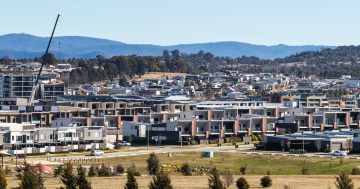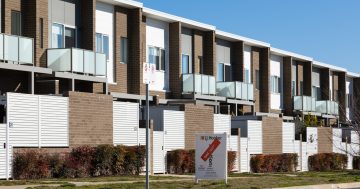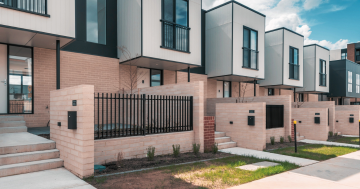
Jo Clay and Greens leader Shane Rattenbury. Photo: Michelle Kroll.
What kind of Canberra do you want in 10 years? What about in 50?
The Greens want a vibrant city where people can move around easily. We want to preserve our remaining habitat and make sure we have plenty of trees and green spaces near where we live and work.
We want a city where everyone has a home. We want a zero-emissions electric city that can deal with the heatwaves and flooding already locked into our rapidly changing climate.
But in addition to the climate and extinction crises, Canberra is struggling with homelessness, housing affordability, a booming population and a growing gap between rich and poor.
We Greens often talk about how we should manage this. We Greens back high-quality densification, including “missing middle” medium-density housing the community has been calling for because this is the only way to tackle the problems.
We need planning and design settings that deliver a compact city that doesn’t rely on cars. We need careful densification through townhouses and apartments that are well located with services. We need to prioritise liveability in a changing climate and green spaces close to home. We need housing options that support people to stay in their community as they age.
The reality is our current planning and development system doesn’t allow us to do this well. We have had a developer-led system run rife. We’ve had building quality problems and more work needs to be done to improve this.
Congestion is growing three times faster than any other mainland Australian capital. Public and active transport, schools and services have not kept pace with population growth.
We have a mismatch between where the jobs are and where the homes are. Our cheapest homes are on the outskirts of Canberra, locking families and young workers into an expensive car-based commute. We typically either have high-density units or enormous houses for shrinking families and very little in between.
The ACT Parliamentary Governing Agreement commits to a minimum 70 per cent of Canberra’s urban development occurring within our existing footprint. We Greens want this to be 80 per cent with a view to no more sprawl. We’ve secured a 30 per cent canopy coverage target for Canberra and commitment to plenty of green spaces to offset the heat island effect.
We need our planning system to provide the choices Canberrans want. More than 80 per cent of Canberra’s residential land is in the RZ1 zone, which mostly allows for single detached houses. This largely prohibits medium-density options such as separately titled dual occupancies, town houses, low-rise apartments and linked shared space homes.
Many parts of the community are agitating for change. There are calls from community organisations and industry to abolish RZ1 altogether, like Auckland did. There are calls for more targeted upzoning around group centres and transport corridors which leaves most of RZ1 alone.
There are calls for inclusionary zoning that mandates or incentivises minimum affordable housing in all new developments. We’ve seen demonstration housing concepts such as Manor House (four linked but independent residences in the footprint of a traditional family home).
We’ve seen new ways of living, such as co-housing and programs that encourage older single Canberrans to downsize in place by welcoming family members or housemates. Many of these options could be combined and some areas might be excluded, including heritage zones.
All would require easy access services and great public and active transport. We need to keep green infrastructure, trees and open space, both on private blocks and in our public realm.
But four years into a major planning review, we’ve not yet had a proper conversation in Canberra about how to densify. Our rapidly growing population means now we must. We know it’s necessary – the need to address the “missing middle” was a feature of the 2018 Housing Choices Collaboration Hub and most Canberrans agree this is a gap.
We don’t have specific models for increased density on the table in the new Territory Plan, simply yellow highlighted areas for ‘possible future development’. Many people raised these issues during the four-month consultation.
What’s the answer? We don’t have an easy-to-understand description of the different models we could pick. When are we going to talk about what the future densification of Canberra looks like? How do we deliver the missing middle?
The Canberra of the future is not just a destination we arrive at. It is a future we create and the way we get there matters. Let’s have this community conversation, up front and with good information and good will.
Jo Clay is the ACT Greens spokesperson for planning and a Member for Ginninderra.





















